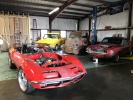Hello everyone
So if I am tuning a stock car for best mpg which is better using the stft ltft vs using a wide band .and how do I start tuning do I straight forward go tune the maf and ve tables or is there something to do first and is it basically about those tables or is there something else to tune like power enrichment timing ...etc what's the perfect way to excute a tune like this.




 Reply With Quote
Reply With Quote


